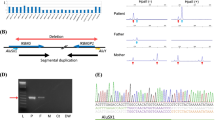Summary
Linkage studies have been performed in 5 incontinentia pigmenti (IP) families totaling 29 potentially informative meioses. Ten probes of the Xp arm were used, six of them were precisely localized on the X chromosome, using hamster x human somatic cell hybrids containing a broken X chromosome derived from an incontinentia pigmenti patient carrying an X;9 translocation [46,XX,t(X;9)(p11.21;q34)]. The following order for probes is proposed: pter-(DXS7, DXS146, DXS255)-IP1-(DXS14, DXS90)-DXS106-qter. The negative lod scores obtained exclude the possibility that in the families studied, the gene for IP is located in Xp11 or in the major part of the Xp arm.
Similar content being viewed by others
References
Ahrens P, Kruse TA (1986) An anonymous X-chromosomal clone identifying a frequent RFLP at Xp21.22 (HGM8 provisional no. DXS207). Nucleic Acids Res 14:7819
Albertsen HM, Ahrens P, Kruse TA (1987) Anonymous X-chromosomal probes revealing DNA polymorphism. Cytogenet Cell Genet 46:569
Aldridge J, Kunkel L, Bruns G, Tantravahi U, Lalond M, Brewster T, Moreau E, Wilson M, Bromley W, Roderick T, Latt SA (1984) A strategy to reveal high-frequency RFLPs along the human X chromosome. Am J Hum Genet 36:546–564
Bruns G, Kunkel LM, Monaco T, Middlesworth W, Bertelson C, Tantravahi U, Bennett K, Lalande M, Aldridge J, Mukai S, Dryja TP, Berson EL, Latt SA (1984) Molecular analysis of the human X chromosome. Cytogenet Cell Genet 37:592
Cannizarro LA, Hecht F (1987) Gene for incontinentia pigmenti maps to band Xp11 with an (X;10)(p11;q22) translocation. Clin Genet 32:66–69
Carney RG (1976) Incontinentia pigmenti. A world statistical analysis. Arch Dermatol 112:535–542
Davatelis G, Siniscalco M, Szabo P (1984) Toward a more complete linkage map of the human X-chromosome. Cytogenet Cell Genet 37:611
Fraser NJ, Boyd Y, Brownlee GG, Craig IW (1987) Multi-allelic RFLP for M27B, an anonymous single copy genomic clone at Xp11.3-Xcen (HGM9 provisional no. DXS255). Nucleic Acids Res 15:9616
Gilgenkrantz S, Tridon P, Pinel-Briquel N, Beurey J, Weber M (1985) Translocation (X;9)(p11;q34) in a girl with incontinentia pigmenti. Ann Génét (Paris) 28:90–92
Hodgson SV, Neville B, Jones RWA, Fear C, Bobrow M (1985) Two cases of X/autosome translocation in female with incontinentia pigmenti. Hum Genet 71:231–234
Hofker MH, Van Ommen CJB, Bergen A, Skraastad MI, Bakker E, Ropers HH, Pearson PL (1984) Strategy for efficient X-probe isolations via cosmid libraries; detection of RFLPs on the X-chromosome. Cytogenet Cell Genet 37:652
Hors-Cayla MC, Heuertz S, Frézal J (1983) Coreactivation of four inactive X genes in hamster x human hybrid and persistence of late replication of reactivated X chromosome. Somatic Cell Genet 9:645–657
Horwich A, Fenton WA, Williams K, Kalousek F, Kraus J, Doolittle RF, Konigsberg W, Rosenberg LE (1984) Structure and expression of a cDNA for the nuclear coded precursor of human mitochondrial ornithine transcarbamylase. Science 224:1068–1074
Iancu T, Komlos L, Shabtay F, Elian E, Halbrecht I, Böök JA (1975) Incontinentia pigmenti. Clin Genet 7:103–110
Kajii T, Tsukahara M, Fukushima Y, Hata A, Matsuo K, Kuroki Y (1985) Translocation (X;13)(p11.21;q21.3) in a girl with incontinentia pigmenti and bilateral retinoblastoma. Ann Génét (Paris) 28:219–223
Kunkel LM, Smith KD, Boyer SH, Borgaonkar DG, Wachtel SS, Miller OJ, Breg R, Jones HW Jr, Rary JM (1977) Analysis of human Y-chromosome specific reiterated DNA in chromosome variants. Proc Natl Acad Sci USA 74:1245–1249
Kunkel LM, Monaco AP, Middlesworth W, Ochs HD, Latt SA (1985) Specific cloning of DNA fragments absent from the DNA of a male patient with an X autosome deletion. Proc Natl Acad Sci USA 81:3442–3446
Kruse TA, Ahrens P, Albertsen HM, Jorgensen B, Vestergaard SR (1986) An anonymous single copy X-chromosome clone, pTAK8, identifies a frequent RFLP at Xp11-q12 (HGM8 no. DXS146). Nucleic Acids Res 14:1921
Lathrop GM, Lalouel JM, Julier C, Ott H (1984) Strategies for multilocus linkage analysis in humans. Proc Natl Acad Sci USA 81: 3443–3446
Lenz W (1961) Zur Genetik der Incontinentia Pigmenti. Ann Paediatr (Basel) 196:149–165
McKusick VA (1986) Mendelian inheritance in man. Catalogs of autosomal dominant, autosomal recessive and X linked phenotypes. Johns Hopkins University Press, Baltimore
Meera Kahn P (1971) Enzyme electrophoresis on cellulose acetate gel: zymogram patterns in man-mouse and man-chinese hamster somatic cell hybrids. Arch Biochem Biophys 145:470–483
Middlesworth W, Bertleson C, Kunkel LM (1985) An RFLP detecting single-copy X chromosome fragment dic56, from Xp22-Xpter (DXS143). Nucleic Acids Res 13:5723
Pontecorvo G (1976) Production of indefinitely multipying mammalian somatic cell hybrids by polyethyleneglycol (PEG) treatment. Somatic Cell Genet 1:397–400
Prigent F (1984) Incontinentia pigmenti. In: Encycl Med Chir (eds) Dermatologie 12470 A10. Paris, pp 1–6
Sefiani A, Hors-Cayla MC, Szpiro-Tapia S, Heuertz S, Gilgenkrantz S, Frézal J (1987) More precise localization of several X probes using somatic cell hybrid. Cytogenet Cell Genet 46:690
Southern E (1975) Detection of specific sequences among DNA fragments by gel electrophoresis. J Mol Biol 98:503–517
Van Ommen GBJ, Bakker E, Hofker M, Wapenaar MC, Pearson PL (1984) The isolation of single-copy X-probes from a cosmid library of a 4 X-cell line. Cytogenet Cell Genet 37:563
Van Someren H, Beijersbergen van Henegouwen H, Los W, Wurzer-Figurelli E, Doppert B, Vervloet M. Meera Kahn P (1974) Enzyme electrophoresis on cellulose acetate gel. Humangenetik 25:189–201
Westerveld A, Visser RPLS, Meera Lahn P, Bootsma D (1971) Loss of human genetic markers in man-chinese hamster somatic cell hybrids. Nature [New Biol] 234:21–24
White R, Lalouel JM (1987) Investigation of genetic linkage in human families. In: Harris H, Hirschron K (eds) Advances in human genetics. Plenum Press, New York London, pp 121–228
Author information
Authors and Affiliations
Rights and permissions
About this article
Cite this article
Sefiani, A., Sinnett, D., Abel, L. et al. Linkage studies do not confirm the cytogenetic location of incontinentia pigmenti on Xp11. Hum Genet 80, 282–286 (1988). https://doi.org/10.1007/BF01790098
Received:
Revised:
Issue Date:
DOI: https://doi.org/10.1007/BF01790098




